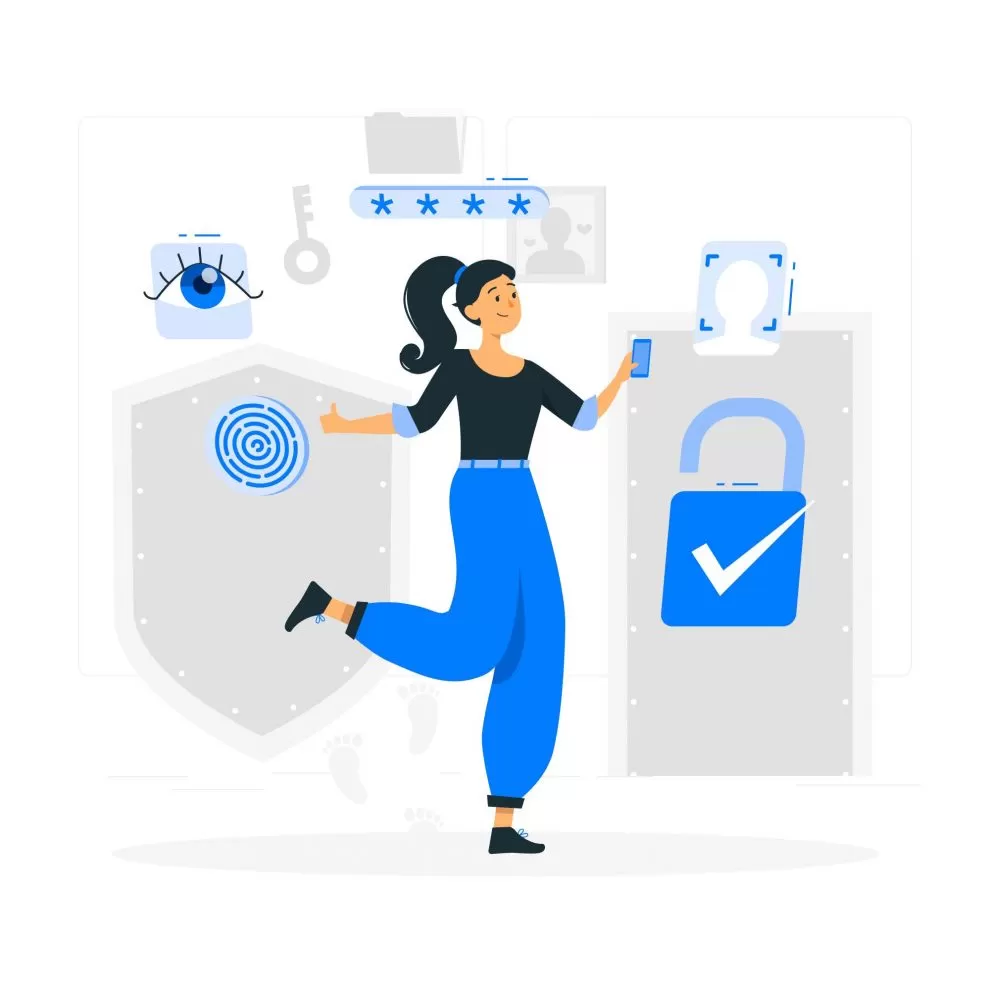In an era dominated by digital interactions, the importance of secure authentication practices cannot be overstated. As we seamlessly traverse the expansive realms of the internet, safeguarding our digital identities has become an imperative task. The concept of secure authentication forms the bedrock of our online security, acting as the first line of defense against an ever-evolving array of cyber threats. This blog aims to unravel the intricacies of secure authentication, shedding light on its fundamental principles and offering actionable insights into fortifying this essential aspect of our digital lives.
As technology advances, so do the methods employed by malicious actors seeking unauthorized access to sensitive information. Against this backdrop, understanding and implementing robust authentication measures is paramount. From exploring the foundational elements of secure authentication to delving into cutting-edge solutions like multi-factor authentication and biometrics, this discourse endeavors to empower individuals and organizations alike in navigating the digital landscape with confidence and resilience. Join us on a journey to enhance your cybersecurity posture as we unravel the key practices that contribute to a more secure online experience.
Understanding the Basics of Secure Authentication
In the dynamic realm of online security, mastering secure authentication is fundamental. This process involves rigorously verifying user identity to permit access to sensitive information, forming a critical defense against evolving cyber threats.
1) The Role of Multi-Factor Authentication (MFA)
In the ever-evolving landscape of cybersecurity, the role of Multi-Factor Authentication (MFA) stands out as a linchpin in fortifying digital defenses. MFA is not merely an additional layer of security; it is a proactive approach that significantly enhances the robustness of secure authentication.
Strengthening Security Layers:
MFA addresses the limitations of relying solely on passwords by introducing multiple forms of identification. By combining something the user knows (password), something they have (a device or token), and something they are (biometric data), MFA establishes a multifaceted barrier against unauthorized access. This strategic combination creates a formidable defense, rendering it exponentially more challenging for malicious actors to breach secure authentication systems.Adapting to Evolving Threats:
As cyber threats become more sophisticated, the static nature of traditional authentication methods becomes a vulnerability. MFA, with its dynamic and adaptive nature, provides a proactive response to these evolving threats. It ensures that even if one authentication factor is compromised, the additional layers serve as a resilient shield, preventing unauthorized access and safeguarding sensitive information.User-Friendly Security:
Contrary to misconceptions about complexity, MFA doesn’t sacrifice user experience for security. Advances in technology have streamlined the MFA process, making it more user-friendly without compromising its effectiveness. By incorporating user-friendly MFA methods, organizations can strike a balance between enhanced security and a seamless, efficient user authentication experience.
Compliance and Regulatory Requirements:
MFA has become a cornerstone in meeting compliance and regulatory requirements across various industries. Many regulatory frameworks mandate the implementation of robust security measures, and MFA is often recognized as a standard practice. By adopting MFA, organizations not only bolster their security posture but also demonstrate a commitment to adhering to industry regulations and standards.Mitigating Risks in Remote Access:
In an era where remote work is prevalent, securing remote access has become paramount. MFA plays a crucial role in mitigating the risks associated with remote authentication. It adds an extra layer of verification, ensuring that even in diverse and potentially less secure environments, the authentication process remains resilient against cyber threats.
Also Read: What PHP Frameworks Should You Be Using in 2024?
2) Password Best Practices
In the digital age, where the security of personal and sensitive information is paramount, adopting robust password best practices is a fundamental step towards fortifying one’s online presence. Understanding and implementing these practices not only enhance individual security but also contribute to a collective effort in thwarting cyber threats.
Complexity Is Key:
The cornerstone of secure authentication lies in crafting complex passwords. Encourage users to create passwords that blend uppercase and lowercase letters, numbers, and symbols. The more intricate the password, the greater the resistance against automated attacks and brute force attempts.Regularly Rotate and Refresh:
Passwords, much like the keys to physical locks, require periodic changing. Regularly rotating passwords adds an additional layer of security by minimizing the window of vulnerability. Advise users to refresh their passwords at predetermined intervals, reducing the risk associated with prolonged use.Unique Passphrases for Every Account:
Repetition is the enemy of security. Advise against using the same password across multiple accounts. Each account should have a unique passphrase to prevent a domino effect in the event of a security breach. This practice ensures that even if one account is compromised, others remain secure.Avoid Common Words and Patterns:
Cyber adversaries often exploit predictable patterns. Discourage the use of easily guessable information, such as birthdays, common words, or sequential numbers. Opt for unconventional combinations that defy patterns, making it exponentially more challenging for attackers to crack the code.Two-Factor Authentication (2FA):
While not a direct password practice, integrating Two-Factor Authentication (2FA) adds an extra layer of defense. Encourage users to enable 2FA wherever possible, as it requires an additional verification step beyond the password. This secondary measure significantly enhances the overall security of the authentication process.Password Managers for Simplified Security:
Managing a plethora of complex passwords can be challenging. Recommend the use of reputable password managers. These tools not only securely store and organize passwords but also generate strong, unique passwords for each account, reducing the burden on users to remember multiple complex combinations.
3) Biometric Authentication: A Cutting-Edge Solution
In the ever-evolving landscape of secure authentication, biometric technology emerges as a cutting-edge solution, revolutionizing the way individuals verify their identities. Biometric authentication leverages unique physical or behavioral traits, providing a level of security that surpasses traditional methods.
Unparalleled Uniqueness:
Biometric data, such as fingerprints, facial features, iris patterns, and even voiceprints, are inherently unique to each individual. This characteristic makes biometric authentication a formidable solution, as it relies on aspects that are nearly impossible to replicate or forge. The inherent distinctiveness of biometric markers ensures a higher level of accuracy in verifying identity compared to traditional password-based methods.Seamless User Experience:
One of the key advantages of biometric authentication is its seamless integration into the user experience. Unlike passwords or PINs, which require active recall and entry, biometric authentication is often passive. Users simply need to present their unique biometric feature, such as a fingerprint or facial scan, making the authentication process both secure and user-friendly.Mitigating the Risks of Credential Theft:
Traditional authentication methods are susceptible to credential theft through various means, such as phishing or hacking. Biometric authentication mitigates these risks by linking identity verification directly to the individual, reducing the reliance on externally stored credentials. This makes it significantly harder for malicious actors to gain unauthorized access through the theft of passwords or tokens.Continuous Advancements in Accuracy:
Advancements in biometric technology continually enhance the accuracy and reliability of authentication systems. Machine learning algorithms and artificial intelligence contribute to refining biometric recognition, ensuring that false positives and negatives are minimized. As the technology evolves, biometric authentication becomes not only more secure but also more adaptable to diverse user characteristics.Privacy and Legal Considerations:
While biometric authentication offers heightened security, privacy concerns and legal considerations must be addressed. Striking the right balance between enhanced security and protecting user privacy is crucial. Clear communication and adherence to data protection regulations ensure that users are comfortable adopting biometric solutions without compromising their personal information.Wide Range of Applications:
Biometric authentication is versatile, finding applications beyond traditional access control. From unlocking smartphones to securing financial transactions and healthcare records, the scope of biometrics is expansive. As technology continues to advance, biometric authentication is poised to play a pivotal role in securing various aspects of our digital and physical lives.
4) Continuous Monitoring for Suspicious Activity
In the dynamic landscape of cybersecurity, where threats constantly evolve, the role of continuous monitoring for suspicious activity has become indispensable. This proactive approach acts as a vigilant guardian, detecting anomalies and potential security breaches in real-time, ensuring a swift and effective response.
Identifying Unusual Patterns:
Continuous monitoring involves scrutinizing user activity to identify unusual patterns that may indicate malicious intent. This could include multiple failed login attempts, access from unfamiliar locations, or abnormal data transfer volumes. By establishing baselines for normal behavior, any deviations trigger alerts, enabling security teams to investigate and respond promptly.Real-Time Alerts: A Proactive Defense:
Real-time alerts play a pivotal role in maintaining secure authentication. When suspicious activity is detected, immediate notifications are sent to security personnel or administrators. This rapid response mechanism allows for swift action, preventing potential security incidents before they escalate. The speed of response is crucial in mitigating the impact of security threats.User Behavior Analytics:
Continuous monitoring goes beyond traditional security measures by incorporating user behavior analytics. By analyzing patterns over time, security systems can develop a nuanced understanding of typical user behavior. This approach enables the identification of deviations that may not be apparent through rule-based detection alone, enhancing the accuracy of threat detection.Network Traffic Analysis:
Monitoring network traffic is an integral component of continuous surveillance. Unusual spikes or patterns in data transfer can signify potential security threats, such as a Distributed Denial of Service (DDoS) attack or data exfiltration. Analyzing network traffic in real-time allows for the swift identification and mitigation of such threats.Proactive Incident Response:
Continuous monitoring sets the stage for a proactive incident response strategy. Rather than reacting to security incidents after they occur, organizations can proactively address potential threats, minimizing the impact and preventing unauthorized access. This approach aligns with the principle that preventing an incident is more effective than mitigating its consequences.Compliance and Security Audits:
For organizations subject to regulatory compliance, continuous monitoring is not only a best practice but often a requirement. Regular security audits, facilitated by continuous monitoring, demonstrate adherence to industry standards and regulatory frameworks. This not only enhances security but also instills confidence among stakeholders regarding the organization’s commitment to data protection.
Also Read: What are the differences between Node.js and Angular?
5) Educating Users on Security Awareness
In the ever-expanding digital landscape, where the line between convenience and vulnerability is often thin, educating users on security awareness has become paramount. Empowering individuals with the knowledge and tools to safeguard their digital presence is not only a proactive approach but a shared responsibility in the collective fight against cyber threats.
Importance of Security Awareness:
Understanding the significance of security awareness is the first step toward fostering a culture of cyber resilience. Users need to recognize that their online actions have implications, and being aware of potential risks is crucial. Security awareness goes beyond the workplace; it is a life skill in the interconnected world we navigate daily.Recognizing Social Engineering Tactics:
Users must be educated on the various tactics employed by cybercriminals, especially those related to social engineering. Phishing emails, deceptive websites, and malicious links are common methods used to exploit human vulnerabilities. Training users to recognize and report these tactics is fundamental in mitigating the risks associated with social engineering attacks.Password Hygiene and Best Practices:
In the realm of security awareness, password hygiene is a cornerstone. Users should be educated on creating strong, unique passwords, avoiding common phrases, and regularly updating their credentials. Introducing password managers can simplify this process, promoting secure practices without overwhelming users.Securing Personal Devices:
As the boundary between personal and professional life blurs, securing personal devices is crucial for overall security. Users should understand the importance of keeping software up to date, enabling security features, and implementing basic cybersecurity measures on their smartphones, tablets, and computers.Privacy Concerns and Data Protection:
Educating users about privacy concerns and data protection principles is integral. Users should be aware of the information they share online, understand privacy settings on various platforms, and grasp the concept of informed consent. This knowledge empowers individuals to make conscious choices about their digital footprint.Responding to Security Incidents:
Preparing users to respond effectively to security incidents is vital in minimizing potential damage. Establish clear reporting mechanisms for suspicious activities, provide guidelines on what to do in case of a security breach, and conduct simulated exercises to reinforce the importance of a swift and coordinated response.Regular Training Sessions and Simulations:
Security awareness is an ongoing process. Regular training sessions, workshops, and simulations keep users informed about the latest threats and security best practices. These interactive sessions not only impart knowledge but also instill a sense of responsibility, turning users into active participants in the overall security posture.
Educating users on security awareness is not just a box to check; it’s a continuous effort to build a cyber-resilient community. By fostering a culture of awareness, providing practical guidance on recognizing threats, promoting good password hygiene, securing personal devices, addressing privacy concerns, and preparing for security incidents, organizations can empower users to be proactive defenders of their digital well-being. In the ever-evolving landscape of cybersecurity, knowledge is the most potent tool, and a well-informed user community is an invaluable asset in the fight against cyber threats.
Conclusion
In navigating the intricate realms of cybersecurity, the importance of secure authentication practices cannot be overstated. From understanding the basics to embracing cutting-edge solutions like multi-factor authentication and biometrics, this exploration has underscored the critical role these measures play in fortifying our digital defenses. Password best practices, continuous monitoring, and user education contribute to the robustness of secure authentication, creating layers of protection against evolving cyber threats.
As we conclude this journey, it becomes evident that security is not a one-time implementation but an ongoing commitment. It’s a dynamic interplay of technology, user awareness, and proactive strategies. By embracing secure authentication practices, individuals and organizations alike can not only safeguard sensitive information but also contribute to a collective effort in creating a more resilient and secure digital landscape. As cyber threats continue to evolve, staying informed, adapting to emerging technologies, and fostering a culture of cybersecurity awareness will be pivotal in navigating the complex terrain of our interconnected world.















